 |
 |
Following are pictures of traditional stringed instruments with a brief explanation of how they are made, how they are tuned, the derivation of their names, etc. There are many more instruments than those indicated here that add to the acoustical magic of our traditional music and which are used by popular musicians of today. These instruments originated from our demotic musical tradition, and it is our duty to preserve them. |
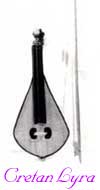 CRETAN LYRA: This instrument is usually made of mulberry wood and carved to become the sound-box of the instrument. The top of the lyra is made of cedar wood. It has threesingle strings and it can be tuned up a-e-a or a-d-a. It can be played with a bow. The player does not tap on the strings but touches them with his nail from the side. There are many kinds of lyras in Crete, and they come with different bows. In Asia Minor and many islands there are lyras with four strings, that can be tuned exactly like the violin e-a-d-g. There are also many kinds of lyras in Thrace-Macedonia that are made in different sizes as well as in the shape of a pear (Achladolyre). CRETAN LYRA: This instrument is usually made of mulberry wood and carved to become the sound-box of the instrument. The top of the lyra is made of cedar wood. It has threesingle strings and it can be tuned up a-e-a or a-d-a. It can be played with a bow. The player does not tap on the strings but touches them with his nail from the side. There are many kinds of lyras in Crete, and they come with different bows. In Asia Minor and many islands there are lyras with four strings, that can be tuned exactly like the violin e-a-d-g. There are also many kinds of lyras in Thrace-Macedonia that are made in different sizes as well as in the shape of a pear (Achladolyre). |
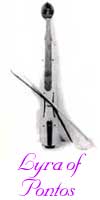 LYRA OF PONTOS (BLACK SEA) or KEMETZES: Usually made of wild plum-tree wood, this lyra has three steel strings; the first called jil; the second, messea (middle); and the third, hamba. The strings are a-e-a or a-d-a. While the performer on the Cretan lyratouches the strings with his nail, the Pontos player taps on the strings, producing a completely different sound since he taps continuously on the middle string to create 4th and 5th intervals with the other two strings. |
 VIOLIN: The violin has been a principal instrument for over 400 years. The first violin appeared in the 7th century and it had one string and a bow. It was introduced to the Europeans by the Arabs. Three strings were introduced in the 10th century; and four strings, the violins present form, were introduced in the 15th century. It is tuned in 5th g-d-a-e. The violin became very popular in Greece; its name was a general term for music. For instance, in old times, people would say, "Let's go to the violins", meaning "Let's go for some music and dance." Other names of the violin in various parts of Greece are Thioli, Diouli (Epirus & Aegina), Vgeloum (Chios), Vieli (Megisti), Ivgili (Siatista), Vgiali. The players of the violin were also called fiddlers (violitzides), avgiolitzides, vgihtzides. It has been claimed by many that the violin came originally from the Arabian single stringed instrument, Rebeck. The best violins manufactured in the world were the Stradivarius, Bertoletti, Amati, Stainer, Matias, Clauds. The most famous violin manufacturing center is the city of Mitenvald, in a valley of the Alps near the border of Austria. VIOLIN: The violin has been a principal instrument for over 400 years. The first violin appeared in the 7th century and it had one string and a bow. It was introduced to the Europeans by the Arabs. Three strings were introduced in the 10th century; and four strings, the violins present form, were introduced in the 15th century. It is tuned in 5th g-d-a-e. The violin became very popular in Greece; its name was a general term for music. For instance, in old times, people would say, "Let's go to the violins", meaning "Let's go for some music and dance." Other names of the violin in various parts of Greece are Thioli, Diouli (Epirus & Aegina), Vgeloum (Chios), Vieli (Megisti), Ivgili (Siatista), Vgiali. The players of the violin were also called fiddlers (violitzides), avgiolitzides, vgihtzides. It has been claimed by many that the violin came originally from the Arabian single stringed instrument, Rebeck. The best violins manufactured in the world were the Stradivarius, Bertoletti, Amati, Stainer, Matias, Clauds. The most famous violin manufacturing center is the city of Mitenvald, in a valley of the Alps near the border of Austria. |
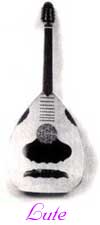 LUTE: This is a stringed instrument with a small body and a long neck. It measures approximately 96.5cm in length, and the body is 37crn in width. In particular, the length of the body is approximately 48cm; the length of the neck is 34.5cm, and the tuning head (karavolo) is 15-17cm. The width of the top is approximately 34.5cm, and the width of the sleeve (maniki) in the upper side is 4.5cm and 5.5cm in the lower side. The depth of the body (skafi) is 16cm. The top of the lute (kapaki) is made of Swedish white wood, without any knots, and the body of kelembeki leaves, of white color for the white lutes and of black color for the darker colored ones. The lute has 4 strings, a-g-d-c, which are tuned one octave higher than the other. The tasta are carved on the neck of the lute to produce the tones and the semitones. The lute is played with a plume (ftero). It is mainly an instrument of accompaniment, so it provides the tune of the song. There are different names for this instrument in various parts of Greece: Lavouto, Lagouto. Certain historians claim that the lute was introduced to Europe from the Spanish, who took it from the Arabs. Its name (laouto) comes from the two double strings that it had years ago, LA and OUT, that is c. There is also an 8-stringed lute (doubles d-a-f-c); and later on, more double strings were added at the lower g and the g at the higher side, that is g-d-a-fc-g. LUTE: This is a stringed instrument with a small body and a long neck. It measures approximately 96.5cm in length, and the body is 37crn in width. In particular, the length of the body is approximately 48cm; the length of the neck is 34.5cm, and the tuning head (karavolo) is 15-17cm. The width of the top is approximately 34.5cm, and the width of the sleeve (maniki) in the upper side is 4.5cm and 5.5cm in the lower side. The depth of the body (skafi) is 16cm. The top of the lute (kapaki) is made of Swedish white wood, without any knots, and the body of kelembeki leaves, of white color for the white lutes and of black color for the darker colored ones. The lute has 4 strings, a-g-d-c, which are tuned one octave higher than the other. The tasta are carved on the neck of the lute to produce the tones and the semitones. The lute is played with a plume (ftero). It is mainly an instrument of accompaniment, so it provides the tune of the song. There are different names for this instrument in various parts of Greece: Lavouto, Lagouto. Certain historians claim that the lute was introduced to Europe from the Spanish, who took it from the Arabs. Its name (laouto) comes from the two double strings that it had years ago, LA and OUT, that is c. There is also an 8-stringed lute (doubles d-a-f-c); and later on, more double strings were added at the lower g and the g at the higher side, that is g-d-a-fc-g. |
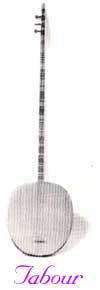 TABOUR: The tabour is made from the wood of the walnut tree (kelembeki), and measures 1.30m in length. It has three double strings, exactly like the bouzouki, and there are many ways to tune it. There are two types of tabour; in the first, the performer uses a pick (vena) to play; while in the other, he uses a bow. Its neck (tastiera) is not divided into semitones, but it has berdedes that separate the scale into commas. The tuning knots that hold the strings are wooden. The strings are usually made of animal gut or plastic wire. The tabour produces a very deep sound due to the length of the strings, as well as a very sweet sound. |
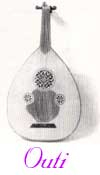 OUTI: The outi (in Arabic, Ud, Al Ud, or Oud) means a wooden instrument, and it belongs to the family of lutes. It was originally made from a single piece of wood, without a neck. In the 9th century it had 5 double strings, and later on-to this day-it still has 5 double strings. At the beginning, the outi was played with the fingers, later with a pick (pena) or a goose feather. Its 5 double strings are tuned by the use of taftophonia, a-g-d-a or g-d-a-e-d. The dimensions of the average outi are: length 87cm; 20cm of this length is the head of the instrument with the tuning knots, and the width of the body is 37cm. The outi is a solo instrument and, as in the case of the guitar, the player can accompany himself by usually tapping the lower strings at a pace. The outi is a blind instrument (tiflo), meaning that its neck (tastiera) is not divided into semitones (tasta). That is why it is so difficult to learn how to play it. The outi can convey the popular styles accurately. |
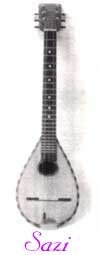 SAZI: There is a whole family of this type of instrument that is different in shape and dimensions. The sazi of this picture measures 1.10m in length, and its tuning knots are wooden. It is made of mulberry wood that is usually carved. It has 3 double strings and can be tuned up in 4ths. Its neck (tastiera) is divided into commas by the berdedes. Usually in the traditional musical instruments there are certain differences from place to place in the type of materials used, the way that the instruments are manufactured, the tuning, the shape, the size, the name of the method of playing, etc. |
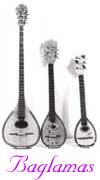 BAGLAMAS: The name of this instrument comes from the Turkish word baglama, which means bond or knot. The modem baglamas is like a small bouzouki. The baglamas is primarily an instrument of accompaniment. It has 3 pairs of strings tuned like the bouzouki d-a-d. In the old days of rembetiko, the baglamas was not quite the same as the bouzouki- it had 3 pairs of strings, but it was tuned differently: for instance e-b-e, with specific tuning instruments, kourdismata, which the rembetes called douzenia or baglamadodouzenia. They only had 5 or 7 tasta, and they were played by the opening and closing of one's left hand. Baglamas measure approximately 3536cm in length. They come in many shapes, with different bodies (skafis) or necks (cheri), as shown in the accompanying photograph. |
 TZOURAS: This is a small version of baglamas, with a very small body (kavouraki), the size of a serving spoon. It is made of mulberry wood and is carved. Its name is Turkish (tzoura, meaning little / small). The neck of the tzouras is longer than that of baglamas. |
 TAMBOURAS: This is the Patriarch of the bouzouki and baglamas. It is a very old instrument, known since the 10th century. It was also known to the Assyrians and the Egyptians, and it had from 2 to 6 strings. From there, it was passed on to the Arabs and called toubour. The toubour was the same as the Byzantine tambouras in its construction. It looked like a mandolin (mandolino) with a very long neck, 2 strings and 5 tasta. This is a confirmation that our traditional folk music has very old mots. Markos, Vamvakaris also mentions that the baglamas of 1900-1930 had 5 or 7 tasta. The two strings were tuned in 5th notes. The Byzantine tambouras was also named Pandouris or Pandoura or Fandouros. There were many sizes of tambouras, and the number of strings was in dose relation to their size. The small or medium tambouras had 2 or 3 strings, while a very large tambouras of Persion origin, Tambour Bouzouk, had six. Different instruments used in the East are from the largest to the smallest, as follows: Meidan Sazi, Tsengouz, Anti-saz, Bouzouk, Baglama, Tamboura, Tsoura. The latter took its name from the Turkish instrument Tzoura, which means very small. From the same Turkish work comes the tsouras or tZoura, which means very small: for instance, "Give me a tzoura (sip) to drink." Baglamas took its name from the Turkish word baglama, which means the knot that the instrument has in its neck (according to Turkish musicologist, Mahmud P. Gazimihal). Among the different kinds of tambouras there are some with mobile tasta, usually made of animal gut in a way that can be tosy for the player to play tones, semitones, 3 semitones and commas, and other tambouras with permanent metallic tasta. According to musicologist Wright, there was an Arabic tambouras that had up to 100 tasta. Until 1920, tambouras were made of carved mulberry wood in the Peloponnese, with strings of thin wire. |
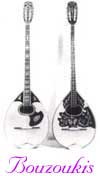 BOUZOUKI: The bouzouki at first was a 3-stringed instrument with 3 pairs of strings; the first ones tuned in 5ths and the third set of notes of the first string tuned in octave d-a-d. There is also a 4-stringed bouzouki (established by Manolis Chiotis, who was known for his virtuosity), tuned c-a-f-c. This measures 0.70-100cm in length. One of the most famous bouzouki manufacturers was Joseph from Piraeus, who built them for Vamvakaris, Papaiouannou, etc. According to Vamvakaris, Joseph was an assistant in the shop of Konstantis Delis, from Syros, who was also a famous bouzouki maker. When Delis died, Joseph took over the shop. Another famous manufacturer and artist is named Theophilos, the only important bouzouki maker left in Greece. He makes 10 kinds of bouzouki, lute, santouri, outi, kanonaki, etc. The best bouzouki is made of mulberry wood, which has a red hue. The bouzouki is called by other names in various parts of Greece: tsiouri, kivouri, bouzouri. In the days of rembetes, bouzouki consisted of the body (skafos) with its top, and the tachera. The tachera is divided into berdedes, and at the upper side are the striftaria with the kordatoura or telia. BOUZOUKI: The bouzouki at first was a 3-stringed instrument with 3 pairs of strings; the first ones tuned in 5ths and the third set of notes of the first string tuned in octave d-a-d. There is also a 4-stringed bouzouki (established by Manolis Chiotis, who was known for his virtuosity), tuned c-a-f-c. This measures 0.70-100cm in length. One of the most famous bouzouki manufacturers was Joseph from Piraeus, who built them for Vamvakaris, Papaiouannou, etc. According to Vamvakaris, Joseph was an assistant in the shop of Konstantis Delis, from Syros, who was also a famous bouzouki maker. When Delis died, Joseph took over the shop. Another famous manufacturer and artist is named Theophilos, the only important bouzouki maker left in Greece. He makes 10 kinds of bouzouki, lute, santouri, outi, kanonaki, etc. The best bouzouki is made of mulberry wood, which has a red hue. The bouzouki is called by other names in various parts of Greece: tsiouri, kivouri, bouzouri. In the days of rembetes, bouzouki consisted of the body (skafos) with its top, and the tachera. The tachera is divided into berdedes, and at the upper side are the striftaria with the kordatoura or telia. |
 SANTOURI: A very old instrument, the santouri is possibly the ancient Psalterion or Epigonio. Its name is possibly from the Persian santour or santir. Its shape is trapezoid, with a sound box of 4-5cm in length and measures 50-65cm in width or 100cm in length. On the top of the sound box, the strings are located in 2, 3 or 4th, tuned in tafto phonia. The bass strings are single. There are also two kavalli that divide the instrument into two parts. On the first part, the strings are tuned according to the diatonic scale; while on the other, the strings are tuned according to the chromatic scale. It has 100-140 strings and produces 30-32 notes. The high strings are made of bronze or steel, and the bass strings are made of copper. It has 7 contrabass strings with a range of 3 octaves. It starts from f-contrabass and ends in b. It is played by using two mallets that have thread or cotton at the end so they can produce a soft sound. It is an instrument of accompaniment. It is made of pine or walnut wood. In. Greece, Tasos Diakogiorgis is a famous teacher and the best player of the santouri. SANTOURI: A very old instrument, the santouri is possibly the ancient Psalterion or Epigonio. Its name is possibly from the Persian santour or santir. Its shape is trapezoid, with a sound box of 4-5cm in length and measures 50-65cm in width or 100cm in length. On the top of the sound box, the strings are located in 2, 3 or 4th, tuned in tafto phonia. The bass strings are single. There are also two kavalli that divide the instrument into two parts. On the first part, the strings are tuned according to the diatonic scale; while on the other, the strings are tuned according to the chromatic scale. It has 100-140 strings and produces 30-32 notes. The high strings are made of bronze or steel, and the bass strings are made of copper. It has 7 contrabass strings with a range of 3 octaves. It starts from f-contrabass and ends in b. It is played by using two mallets that have thread or cotton at the end so they can produce a soft sound. It is an instrument of accompaniment. It is made of pine or walnut wood. In. Greece, Tasos Diakogiorgis is a famous teacher and the best player of the santouri. |
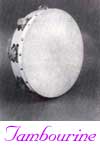 DEFI (TAMBOURINE): While its name is Turkish, this instrument was called sistron in ancient Greece. In other parts of Greece today, the instrument is called daifes or dacheres (East Macedonia and Thrace), tsaboutsas (Cyprus), and agrana (Epirus). Its size varies from 20 to 40cm in diameter and it has two sides; one is open, and the other is closed with a membrane. There are two types of defi: a simple one with no cymbals, and one with 1-6 pairs of cymbals. The wooden part of the defi is call kansa. In our popular music, singers play the tambourine to keep the beat of the tune and to create a happy atmosphere. DEFI (TAMBOURINE): While its name is Turkish, this instrument was called sistron in ancient Greece. In other parts of Greece today, the instrument is called daifes or dacheres (East Macedonia and Thrace), tsaboutsas (Cyprus), and agrana (Epirus). Its size varies from 20 to 40cm in diameter and it has two sides; one is open, and the other is closed with a membrane. There are two types of defi: a simple one with no cymbals, and one with 1-6 pairs of cymbals. The wooden part of the defi is call kansa. In our popular music, singers play the tambourine to keep the beat of the tune and to create a happy atmosphere. |
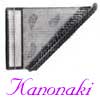 KANONAKI: This instrument is made of cedar or plane tree wood. It has a triangular shape, and its sound box measures 1.06cm in length and 44cm in width. It is tuned according to the chromatic scale, and every note consists of double strings tuned in taftophonia. It has 72 plastic strings, and the average string produces 24 notes, ranging in 3 octaves. In the kanonaki, each octave is divided into 72 commas. Another type of kanonaki is played with two sharp springs fitted to the index finger of the left and right hand. It is believed that the Greek mathematician Pythagoras performed experiments to determine the notes using the length and thickness of the strings of this instrument. Stephanidis was one of the best performers of this very difficult instrument, and there are very few instrumental musicians who play the kanonaki today in Greece. |
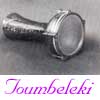 TOUMBELEKI: This is a small drum, made of metal or clay. Having a cylindrical shape, one side is open and the other side has a leather membrane. It is a percussion instrument which is also called tymbeleki in Evroa, tsimbourleki in Thessaly, and tarabouka in Lesvos. |
Clink on any of the links below to go to those webpages: Musica Byzantia Ensemble Performing Artists and Orchestras CD Releases More Music News & Articles A Brief History of Greek Music Traditional Stringed Instruments of Greece A Tribute to Greek Musicians of the Past Greek Musical Scores Audio Files Downloads |
HCS encourages readers to view other articles and releases in our permanent, extensive archives at the URL http://www.helleniccomserve.com/contents.html. |
|
|
2000 © Hellenic Communication Service, L.L.C. All Rights Reserved. http://www.HellenicComServe.com |
